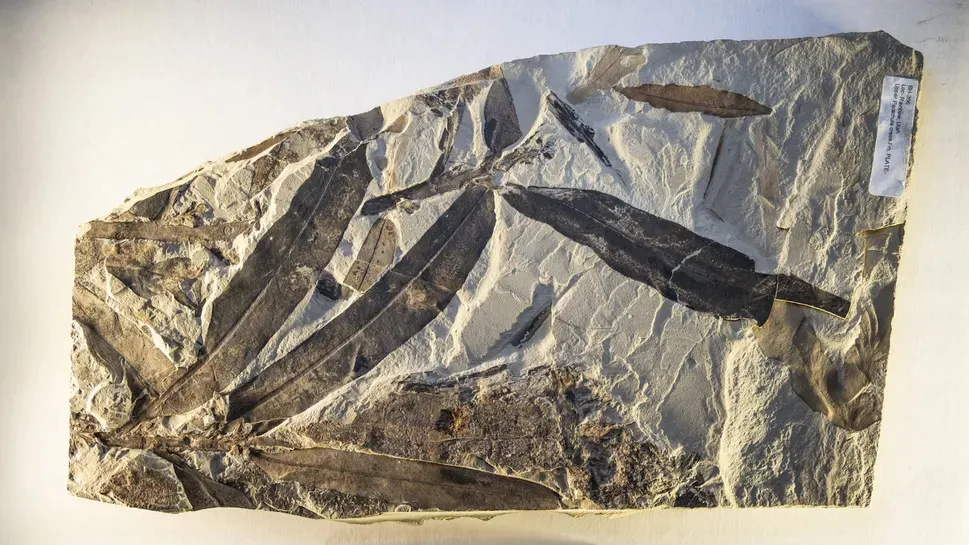Utah, a state renowned for its majestic natural landscapes, stunning national parks, and rich mining history, harbors another intriguing allure: ghost towns. Here, time seems to stand still, and tales of the past, sometimes tinged with mystery, still echo. Among these ghost towns, a remarkable scientific discovery has captured the attention of the scientific community – the fossil of a peculiar plant, dubbed the “alien plant,” revealing secrets of a vanished ancient ecosystem.
Unearthing the “Alien Plant” Fossil Near Rainbow Ghost Town
In 1969, paleontologists unearthed an extraordinary fossil leaf near a ghost town in Utah. This specimen was named Othniophyton elongatum. Initially, scientists speculated that it was an extinct plant, possibly related to ginseng, due to the partial resemblance in leaf shape.

The Othniophyton elongatum fossil was first discovered near a ghost town in Utah, raising numerous questions about plant evolution.
Recently, a breakthrough occurred when Steven Manchester, a paleobotanist, stumbled upon another fossil leaf in the paleobotanical collection at the University of California, Berkeley. Surprisingly, after meticulous analysis, Mr. Manchester’s research team concluded that this specimen and the one found in 1969 belonged to the same plant species. Both fossils were excavated from the Green River Formation, near the ghost town of Rainbow.
Green River Formation: A Time Capsule Preserving the Past
The Green River Formation is a renowned paleontological site, celebrated for its exceptionally well-preserved fossils. Approximately 47 million years ago, this area was a vast lake ecosystem, situated near active volcanoes. Sediments from the lake and volcanic ash created an ideal environment for preserving the remains of organisms, including fish, reptiles, birds, and plants.
Thanks to this slow preservation process, scientists can study these fossils and gain insights into past life. The discovery of Othniophyton elongatum within the Green River Formation further enhances the scientific significance of this region, allowing us to explore a unique plant species that once thrived in an ancient ecosystem.
The Mystery of the “Alien Plant”
What sets Othniophyton elongatum apart is its dissimilarity to any plant species known today. Mr. Manchester’s team analyzed the physical characteristics of the two fossil specimens and compared them to over 400 families of flowering plants living today, as well as extinct plant families. However, they could not establish any connection between Othniophyton elongatum and other plant species.

Reconstruction of Othniophyton elongatum, showcasing its unique and unlike any currently known plant.
Utilizing microscopy and artificial intelligence (AI) technology, the research team observed at a microscopic level the tiny seeds developing inside the fruit of the fossil specimen, as well as the stamens. They discovered that the stamens remained intact and did not fall off when the fruit ripened and prepared to disperse seeds – a characteristic never before seen in any modern plant species.
These peculiar features have led scientists to call Othniophyton elongatum the “alien plant” because it appears to belong to no known evolutionary lineage.
Significance of the Discovery
The discovery of Othniophyton elongatum is crucial for understanding plant evolution. It reveals that in the past, unique plant species existed on Earth, which subsequently became extinct and left no descendants.
Furthermore, this discovery underscores the importance of preserving paleontological sites like the Green River Formation. These areas are “time capsules” that hold evidence of the past, helping us better understand the history of life on our planet.
Visiting Ghost Towns: A Journey Back in Time
Visiting ghost towns in Utah is not just a tourist trip, but also a journey back in time, exploring the remnants of a bygone era. These towns, with their abandoned buildings and deserted streets, evoke a sense of mystery and nostalgia for historical narratives.
As you explore these ghost towns, remember that you are walking on lands that were once home to real people, with their own dreams, hopes, and disappointments. Take time to imagine their lives and reflect on the passage of time.
And who knows, while exploring these ghost towns, you might stumble upon a new fossil or uncover a previously unknown historical secret. Utah, with its stunning natural landscapes and captivating historical tales, always has something new to discover.
Conclusion
The discovery of the “alien plant” Othniophyton elongatum near the mysterious ghost towns of Utah is a testament to the wonders of science and the richness of natural history. It not only opens a window into the past, revealing an ancient ecosystem and a unique plant species, but also reminds us of the importance of preserving Earth’s natural and cultural heritage. Come to Utah, explore the ghost towns, learn about history, and admire the beauty of nature – you will have an unforgettable travel experience.